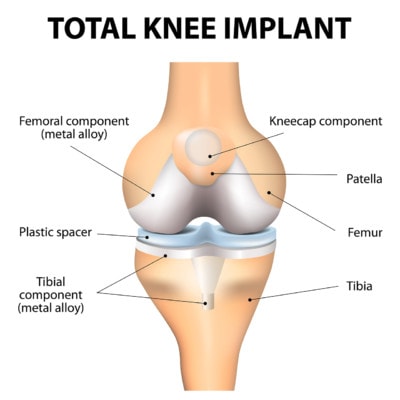Why Are Hips Losing Bone After Knee Replacement?
I blogged, a while back, on our first high-level study of the results of knee replacement that showed pretty lackluster results for amputating a joint and inserting a prosthesis. Now several studies have suggested that some really weird stuff is going on with knee replacements— hip bone loses density after the procedure. The big question is, why is this happening? Is this what causes the increased risk of hip fracture after knee replacement?
The So-So Results of Knee Replacement

Designua/Shutterstock
At best, you may end up with so-so results following a knee replacement, but are so-so results worth this drastic and invasive surgery? One of the most common results patients report is ongoing knee pain after knee replacement. You may hear some patients say the surgery was worth it, however, because they aren’t in as much pain. It seems patients are settling for “not as much pain,” but how much is “not as much pain” following a knee replacement? Some patients report as much as a 5 out of 10 pain level with preoperative levels not much higher than this. In addition, these pain levels tend to climb over time with rates even higher at two or more years following their knee replacement.
Another so-so result with knee replacement—the ability to possibly be more active. But the question is, how much more active? I’ve shared studies on this blog before about the unrealistic expectations regarding activity levels following a knee replacement. Even hoping for a return to normal activity following a knee replacement is a stretch as 5% or less ever actually achieve this. Why are our expectations so grand? TV advertising leads the charge of false hopes on this one, showing knee replacement recipients running after a football or playing Frisbee on the beach. The truth is very few knee replacement patients ever achieve what these commercials show. And if you were not an active person to begin with, before your knee problems began, knee replacement isn’t going to change this.
The Side Effects of Knee Replacement
You can’t consider a knee replacement without considering the side effects associated with it, because if you choose to have your knee amputated and replaced with a prosthetic device, you are choosing the possibility of a heart attack or stroke, metal ions (sheddings from the fake joint) in your blood, and even hip fracture.
Heart attacks and strokes can stem from trauma following a knee replacement. The reason this can happen is because the blood vessels and bone marrow space experience severe trauma as the joint is cut from the leg bones and removed from the body. Blood clot risk is increased, and these clots can travel through the vessels and create a blockage in the heart, causing a heart attack, or in the neck vessels or brain, causing a stroke.
Metal ions from wear particles from the prosthetic knee joint can build up in the blood. Materials used in the prosthetic joints include metal, plastic, ceramic, or a combination and all can be compromised with movement and cause particles to wear off. In addition, patients who have metal allergies can be particularly susceptible to the shedding of knee replacement particles, and this can cause more chronic pain or cause the device to fail and require replacement. In fact, patients who have any allergy (from pet dander to seasonal allergies) can be more susceptible to allergies to their knee replacement device.
Hip fracture after knee replacement has also stepped onto the knee-replacement-risk stage recently. In May, I shared a study out of Sweden that showed hip fracture after knee replacement risk increased by 4%, and now we have a new study exploring this more in depth.
Why Is the Hip Bone Dissolving After Hip Replacement—The New Research
The new study looked at bone density of the hip area after knee replacement. The rationale for performing this study was previous studies that had shown a higher rate of hip fracture after knee replacement surgery within the first year. Hence the research question was whether the hip fractures were coming from bone loss or something else.
Compared to control, the patients who had knee replacement lost more bone on that side in the head of the femur bone and around the hip in general. These patients also lost muscle mass. The authors postulated that perhaps this was due to poor outcomes and less activity. Having said that, another option may the toxicity of the metals in the knee replacement which are a big issue in many patients.
The upshot? Is the increased risk of hip fracture after knee replacement due to bone loss? Not sure anyone knows at this point, but I can say that it’s just one more reason to try to avoid knee replacement!

NOTE: This blog post provides general information to help the reader better understand regenerative medicine, musculoskeletal health, and related subjects. All content provided in this blog, website, or any linked materials, including text, graphics, images, patient profiles, outcomes, and information, are not intended and should not be considered or used as a substitute for medical advice, diagnosis, or treatment. Please always consult with a professional and certified healthcare provider to discuss if a treatment is right for you.
